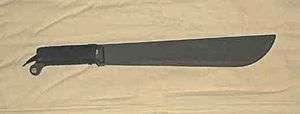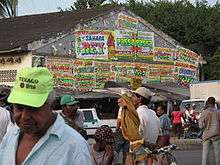Champeta
| Champeta | |
|---|---|
| Stylistic origins | Soukous, highlife, mbquanga, juju, ragga, compás haitiano, bullerengue, mapalé, zambapalo, chalupa |
| Cultural origins | Early-1980s, Colombia |
| Typical instruments | Voice, percussion, bass, electric guitar, synthesiser, keyboard |
| Subgenres | |
| Champeta criolla , champeta urbana , champeta africana | |
| Regional scenes | |
| Colombia | |
| Local scenes | |
| Cartagena, Palenque of San Basilio | |
Champeta is a genre of folk music and dance originating in the Atlantic coastal regions of Colombia.
Champeta originated among inhabitants of African descent of the Colombian cities of Cartagena de Indias and Barranquilla, and was linked with the culture of the Palenque of San Basilio district. It shows influences of musical genres from Euro-African colonial settlements and from the continent of Africa. [1]
Background
The word “champeta” originally denoted a short, curved knife of the same name, used in the region at work, in the kitchen and as an offensive weapon. The word is first known to have been used as a cultural identifier in the 1920s. It was used to identify a dance in the 1970s and a musical genre in the 1980s.

Socio-cultural researchers and sociologists have established that at some time before the 1920s the term “champetudo” started to be applied to residents of the more outlying districts of Cartagena, who tended to be poorer and of African descent. The term was applied by the economic élite with the intention of disparaging this surviving culture, with associations of vulgarity, poverty and blackness. Thus “champeta” refers to a culture whose history is marked by slavery and mistreatment. At the start of the 1970s Champeta culture became better-known in Colombia due to the development of a set of complex dances set to the rhythms of salsa and jíbaro and later reggae. This music was played at full volume through big loudspeakers known locally as “picós” (from the English word “pick-up”). These early dances were called “therapy” for their relaxing nature, a distraction from the economic problems of the country.
Development of the musical genre
Around 1981 “creole therapy” emerged as a musical genre to be performed and sung. Among its sources of inspiration was recorded music brought into the port of Cartagena from Africa and from other Euro-African settlements. Its first composers were people of African descent from Cartagena and Palenque de San Basilio, later joined by songwriters and entrepreneurs from Barranquilla and other parts of Colombia. It consisted in a fusion of African rhythms (soukous, highlife, mbquanga, juju) with those from the Antilles (ragga, compás haitiano, also influenced by music of Indigenous and Afro-Colombian origins (bullerengue, mapalé, zambapalo and chalupa). This style of music came to be known as “Colombian therapy” and finally took on the name of the “champeta” culture.[2] During the 1990s champeta underwent further changes in its musical and other content, with the introduction of digital techniques and “placas” (interruptions counter to the rhythm). Despite its social origins, champeta came to be as much appreciated as rejected by the social élite.
Musical content
In champeta music the rhythmic base dominates over the melodic and harmonic lines, producing a music easy to dance to and marked by its strength and plasticity. The instruments used include the voice, percussion, electric guitar, bass, conga drums, and the synthesiser which contributes rhythmic effects. This musical form is characterised by a division into three sequential parts: the introductory music, the chorus, and a third element known as “el Despeluque”, marked by powerful repetitive rhythms and usually accompanied by “placas”. Song lyrics often display the rebellious attitude of Cartagena people of African descent, challenging social and economic exclusion or relating their dreams of change and progress.
Cultural aspects

The standard conception of champeta includes four central aspects: musical expression, the distinctive language, the loudspeakers (“picós”), and the “perreos” – celebrations. Some give equal importance to other aspects such as dance, political activism, costume, or videos. More recently this cultural phenomenon has spread to other art forms such as cinema, literature and the plastic arts.[1]
Performers
Abril and Soto (2004) identify as “champeta stars” those artists who have transcended their local background and signed contracts with big national and international music companies. These include “El Sayayín” (Jhon Jairo Sayas), “Mr. Black El Presidente Del Genero” (Edwin Antequera), “El Afinaito” (Sergio Liñan), “Álvaro El Bárbaro” (Álvaro Zapata), “Elio Boom” (Francisco Corrales), "El Intelectual" Kevin Florez, Twister El Rey, “Yao & Zaa” Viviano Torres, Eddy Jey, among others. Torres joined the first singers of the genre to form the group Anne Swing which achieved international fame at the end of the 1980s, appearing in the United States “Top 40”. More recent performers include “El Jhonky el profeta” (Jhon Einster Gutíerrez Cassianis), who died in 2005; “El Michel” who created an anthem-like song about the champeta way of life; Leo Fenix, Karly Way and El Oveja. El Yao, young f, Zaider, Jeivy Dance, King Kayze, Mr Anthony, J Manny, Jeizy Bow, Boby Sierra
Performers of related genres
- The singer Carlos Vives adopted the Terapia-Champeta genre in the song Pa' Maite and shows some of this influence elsewhere.[3]
- The salsa singer Joe Arroyo aiming to highlight what is of African or Indigenous origin in the Caribbean and Cartagena, combines various African musical influences such as champeta, and is described on many of his discs as ”champetuo”, for example La rebelión.
Cinema
- Cimarrones al filo de la champeta (2008) produced and directed by Jorge Benítez, was the first film about champeta culture to be based on the everyday life and the stereotype of the “champetudo”.
- La gorra, made by Andres Lozano Pineda also in 2008.
- Bandoleros (2006) directed by Erlyn Salgado recognised by the journalist Ricardo Chica and the researcher Rafael Escallón as the first film to display champeta culture. It was filmed using a cellphone and a Handycam camera, and is notable for having been distributed through informal markets, as is normal for Therapy music.
Nightlife
In Colombia there are many night clubs were people can go dancing to the sound of champeta music.
- In Cartagena de Indias, in the Bazurto neighbourhood, there is a place called Bazurto Social Club, next to the Centenario park, were live bands play champeta in the colourful walls that relate to Cartagena's history. Opened from Thursday to Saturday, from 19:00 until 3:00, it's a great place to learn some of the champeta's moves. [4]
- In Bogota, in the zona rosa, there's a bar called Campanario, where a live band plays all the tropical rhythms such as champeta, reggeaton, reggae, and even calypso. Opened from Wednesday to Saturday, from 19:00 until 3:00, it is recommended to be there early because it is a small, popular and quite crowded bar. [5]
References
- 1 2 Contreras Hernández, 2002
- ↑ Escallón Miranda, 2007
- ↑ Article by Lena Hansen on a concert of Carlos Vives, originally published in the Miami Herald
- ↑ Article by This Is Cartagena on Cartagena's Music Bars, Bazurto Social Club
- ↑ Article by Vive In on Campanario
Bibliography
- Marion Provenzal, Claudia Mosquera (2000). Construcción de identidad Caribeña popular en Cartagena de Indias a través de la música y el baile de la champeta [Construction of a Caribbean identity for people of Cartagena through Champeta music and dance, vol. 3, pp. 98-114] (in Spanish).
- Nicolás R. Contreras Hernández (2002). Champeta-Terapia: un pretexto para revisitar las ciudadanías culturales en el Gran Caribe (En: Champeta-Terapia: an excuse for revisiting cultural citizenships in the Greater Caribbean), Comfamiliar.
- Elisabeth Cunin (2003). Identidades a flor de piel: lo “negro” entre apariencias y pertenencias: categorías raciales y mestizaje en Cartagena(En: Skin-deep Identities: "blackness" between appearances and possessions: miscegenation and racial categories in Cartagena, Ch, 5, Instituto Colombiano de Antropología e Historia, Universidad de los Andes, Instituto Francés de Estudios Andinos, Observatorio del Caribe Colombiano, Bogotá Web.
- Carmen Abril, Mauricio Soto (2004). Colección economía y cultura [Economic and cultural collection] (in Spanish). Bogotá: Observatorio del Caribe Colombiano, Convenio Andrés Bello. ISBN 958-698-149-5.
- Eduardo Restrepo, Axel Rojas (eds.) (2004). Conflicto e (In)visibilidad: Retos en los estudios de la gente negra en Colombia (En: Conflict and (In)visibility: Challenges in the study of black people in Colombia): Elisabeth Cunin, discográfica de Cartagena de la esclavitud al multiculturalismo: el antropólogo, entre identidad rechazada e identidad instrumentalizada, p. 24 and 148; Carlos Efren Agudelo, no todos vienen del rio: construcción de identidades negras urbanas y movilización política en Colombia, p.191. Editorial Universidad del Cauca.Web
- Adolfo González Henríquez, Carmen Abril (2005). Entre la Espada y la Pared, el futuro económico y cultural de la industria discográfica de Cartagena (En: On the Horns of a Dilemma: the economic and cultural future of the recorded music industry of Cartagena, Vol, 1, No. 2, Convenio Andrés Bello y el Observatorio del Caribe, Web.
- R. Escallón Miranda (2007). La Polarización de la Champeta: Investigación que motivó el reconocimiento de esta cultura y de este género en el Salón Regional y Nacional de Colombia (En: The Polarization of Champeta), Roztro - Museo de Arte Moderno de Cartagena, Vol, 1, no. 2.